Ziggy Strings tutorial
This tutorial was created as a part of Scrap Attack
When I first envisioned my Ziggy Strings quilt, I was actually channeling a herringbone style. I drew thin neutral strips to divide each block on diagonal and imagined them connecting neatly to form a sashing background. I'd use foundation paper to ensure the neutral strips met up easily. Otherwise, the blocks would be filled out with colorful scrappy strips of random sizes, left to meet willy nilly. I wanted to create deeply angled V's using the long, rectangular blocks with the colors connecting from one row to the next.
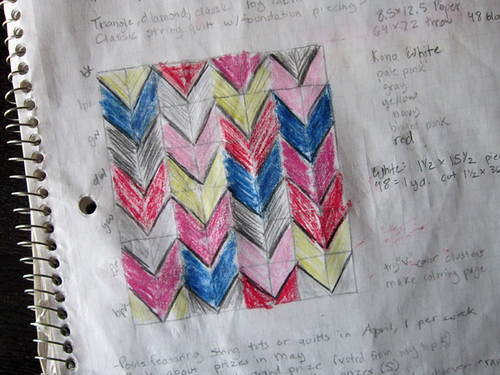
The best way to emphasize the herringbone style would be to make individual V's, with different colors. And I thought a dark sashing like Kona pepper would do nicely to spice things up. But once I put my ideas on paper, I realized I wanted continuous color zigzaging in rows across the quilt. You know, like a classic zigzag quilt, but with strings. I still think the individual herringbone V's would rock though. Maybe you can make that one for me?
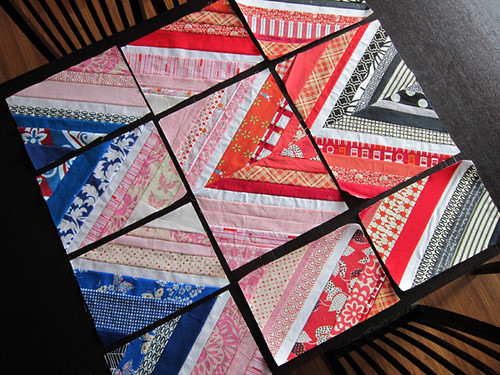
Here's where I'm at today. I've connecting a few finished blocks there, if you look closely. I'm not sure if I'm going to continue in that manner, or add thin white sashing vertically and horizontally to space the blocks out as a broken zigzag. So, see how I've left space between most of the blocks? That could be white sashing or not. We'll see.

Lots of ways to use these blocks! You'll have to choose your own adventure. Do note that if you sew all the blocks together without sashing, the colorful V's will be nice and sharp, but the thin neutral diagonal strips will have dull points (see above). Making sharp points on the neutral strips is doable, but would would have made the V's not so deeply angled. Right now, I 'm all about the angle!
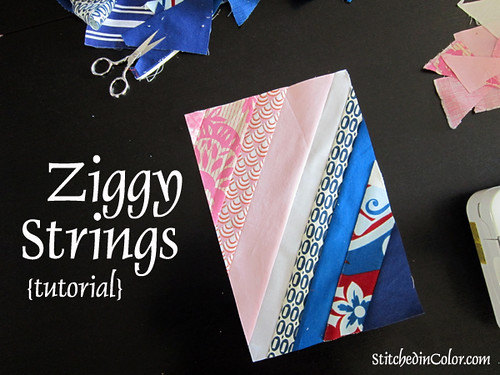
Ziggy Strings Tutorial
::Supplies::
Legal-sized copy paper (48 sheets)
Glue stick
Dull machine sewing needle (or prepare to dull the one you have!)
1 yard solid neutral fabric
Colorful fabric strips ranging from 1 - 3" wide. Choose 7 different colors for a continuous zigzag quilt, like mine.
::Finished Size::
Each block finishes 8" x 12". An 8 x 6 block layout (48 blocks) makes a 64" x 72" throw quilt.
::Prepare::
Trim regular legal copy paper to 8.5" x 12.5". You just have to trim one edge, so this shouldn't be such a terrible chore. I borrowed a paper cutter! Be exact as the papers are going to be a foundation guide for making blocks.
You're going to be sewing through paper, which will dull a new needle quickly. Fit your sewing machine with a dull sewing needle, if you have one. I save a needle marked "paper" for these tasks. Set the machine to a shorter-than-normal stitch length, such as 1.5. The short stitch length will perforate the paper, making it easy to remove after completing the blocks.
Grab some crayons, pastels, or whatever to draw your color layout. If you are doing a continuous zigzag, you can simple draw 7 squiggly lines representing your color order. If you are doing individual V's more like herringbones, you should sketch out the quilt, representing all blocks accurately, so you can color in V's one by one. Refer to your color layout as you make blocks.
::Cutting::
Cut your neutral sashing fabric into (48) 1.5" x 15.5" strips. If cutting from a 1 yard piece, it's most economical to cut 36" long strips, not 44" long strips (width-of-fabric or WOF). If you cut 1.5" strips from selvedge to selvedge (WOF) you will only be able to make (2) 15.5" strips from that cut and much will be wasted. Instead, cut along the 36" length of the fabric (the lengthwise grain) to cut (24) 1.5" x 36" strips. Bisect each into (2) 15.5" strips with just 5" of waste.
Prepare your colorful fabric strips by trimming them straight on each long side. No need to trim them to a certain width or length. The paper foundation will help with that!
::Sewing::
Consulting your color diagram, choose which block you are making. Note if the diagonal sashing strip is slanted from the top left or top right corner. The blocks across a row must alternate in slant direction!
Fold the end of a neutral sashing strip symmetrically to make a fold at center. Make a similar fold in the opposite end so that center is marked on both sides. Place the sashing strip diagonally on a foundation paper so that the center of the strip aligns with the corner of the paper.

Use your glue stick to baste the strip in place. I like to apply the glue to the paper at one corner and run the glue lightly along the paper all the way diagonally to the next corner. Then, press the strip in place firmly.
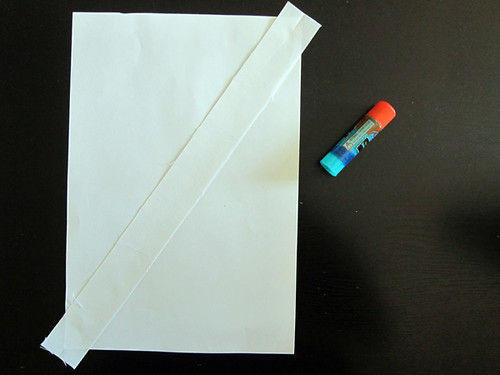
Choose two colorful fabric strips that are long enough to cover the paper when placed alongside the sashing.
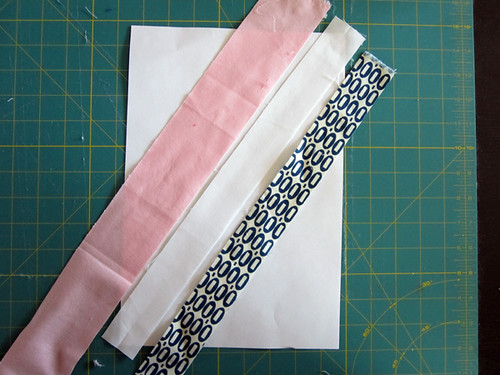
Place one of the chosen strips right side down on the neutral strip, aligning the raw edges. Sew a normal 1/4" seam. You will sew right through the paper!
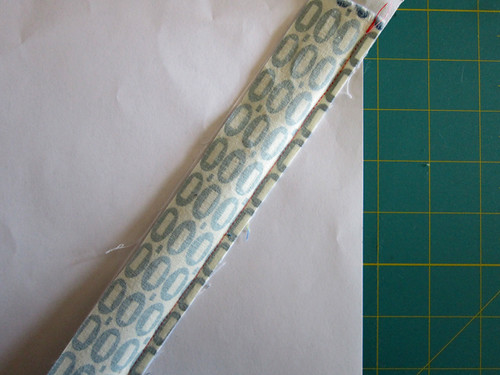
When you open that first seam, both fabrics will hold fast to the paper.
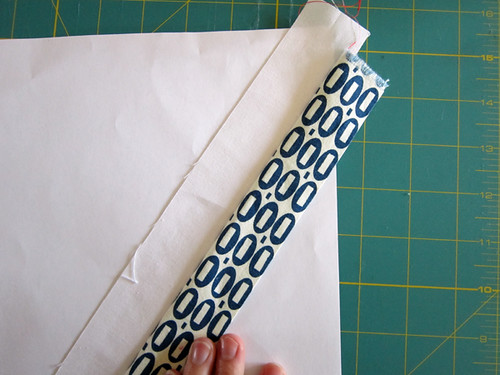
Before getting up to press the seam, sew the other colored strip to the opposite side of the neutral sashing.
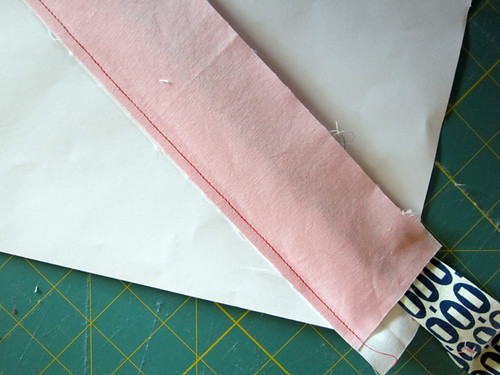
Now press seams open from the right side. Do not use steam, which would warp the paper. If your strips were really long, it can be annoying to have excess fabric trailing from the block. You may want to it trim off, being sure not to trim too close to the paper. These extra bits can be used for future blocks!
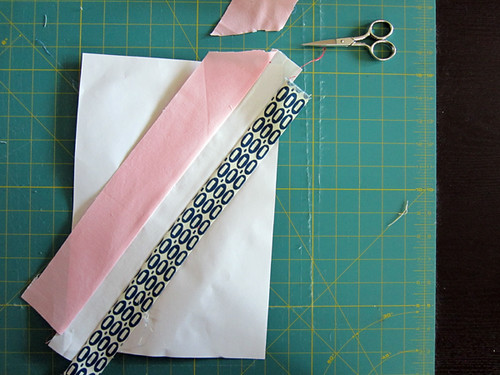
Choose two more strips, one each color. Again, the foundation paper will show you how long the strips need to be. Foundation piecing makes working with scraps easy!
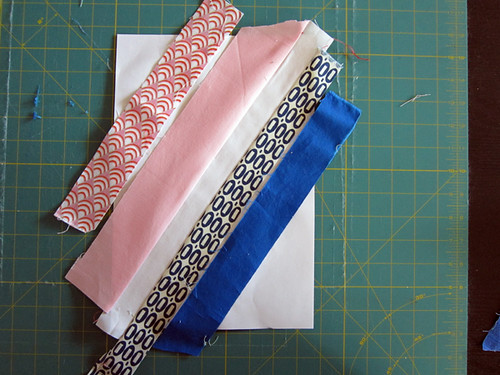
When you have a barely-long-enough piece, just make sure that the new strip extends about a 1/4" off of the paper along the new seam line. Always start sewing about a 1/4" away from the paper to make sure that the diagonal seam fully covers the paper.
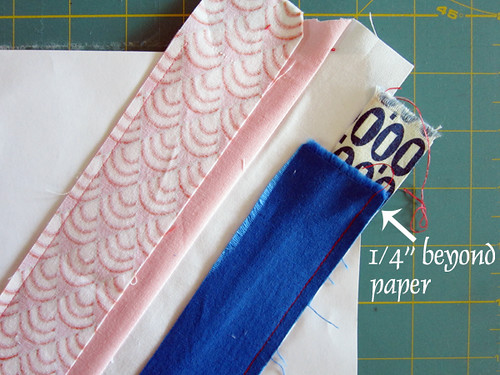
Again, sew strips onto both sides before getting up to press seams open. This is purely a time-saving measure. To further economize your time, make several blocks at once, so you can sew lots of seams before getting up to press!
Continue adding strips in this way until you have completely covered the paper. The very last bit at the corners is a great place to use triangle scraps!
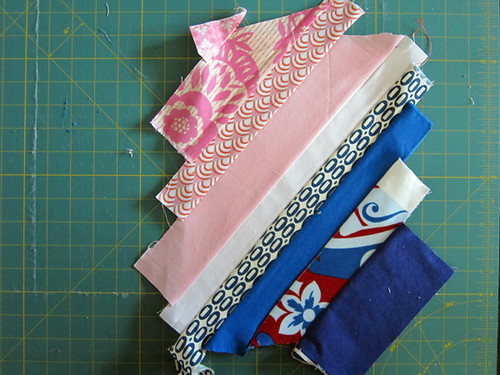
::Finishing::
Now flip the block over and use the foundation paper as a guide for trimming your block to 8.5" x 12.5".
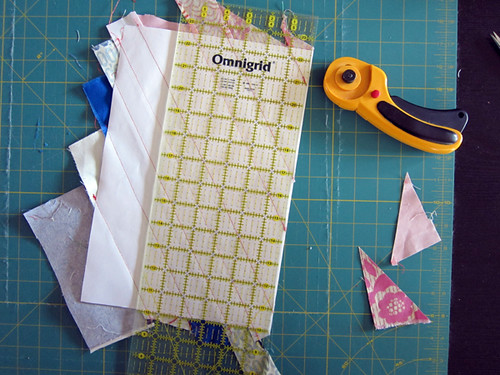
Some of your trimmings are large enough triangles to use as corners for future blocks!
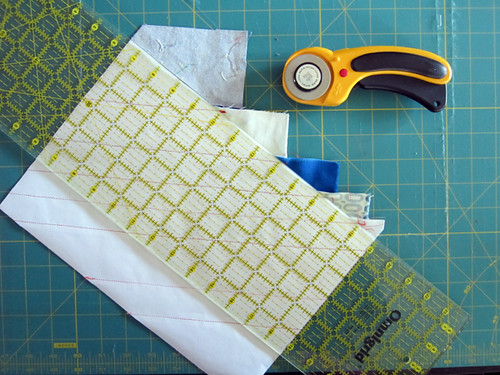
When your block is neatly trimmed it's time to remove papers. I usually make a stack of blocks and remove papers while watching TV. Or, you might have a little one who would love this task!
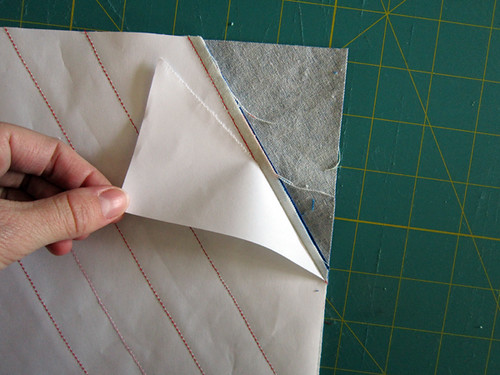
Just fold the paper back along the seam line and rip it off. Start at the outer corners,
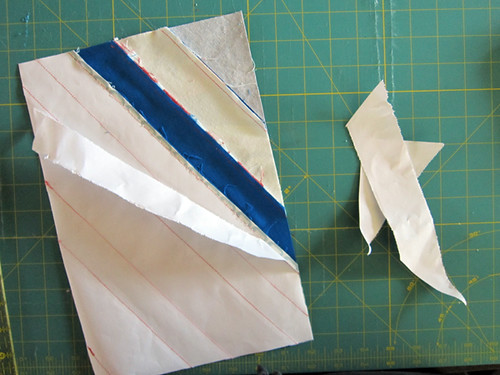
working your way to center.

Ta da!
If blocks are sewn together without adding sashing, your colored portions should meet up in nice sharp V's easily from precise foundation piecing.
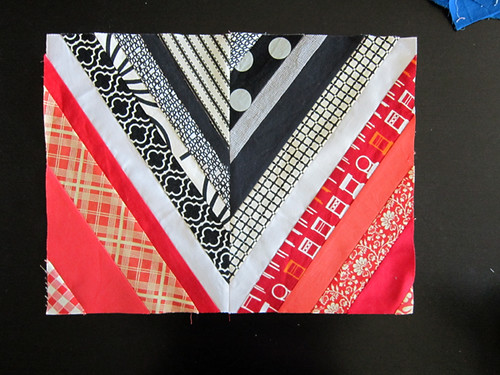
Have fun! If you do one row (8 blocks) per week, you'll have your Ziggy Stripes quilt complete well before the Festival of Strings. I'm not sure if I can hold myself to just one row per week. We'll see!

